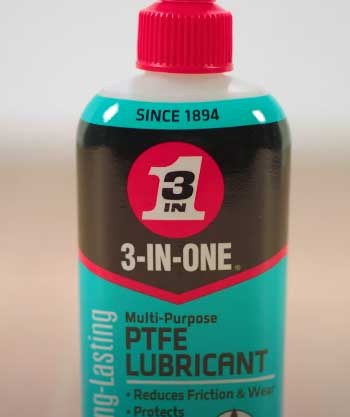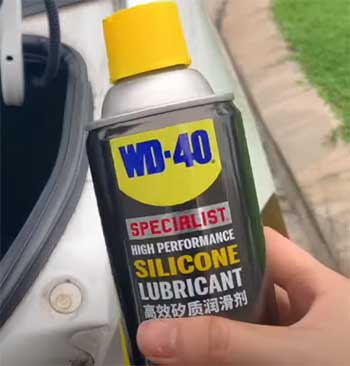A lot of maintenance work requires the use of a lubricant. Whether it’s repairing your car or repairing your machinery, you will need a lubricant for that.
However, finding the perfect lubricant is something you must deal with yourself. Especially, choosing between PTFE lubricant and silicone is a troublesome thing for many people.
That’s why I am here to help you with the whole thing. I will go through an in-detail comparison of both types of lubricant.
So, you can get a better idea of which one you should use in which case.
A Quick Comparison Table
This little comparison table I have can be great for someone who doesn’t have much time on their hands. Let’s take a look at the comparison for both the lubricant options right away –
| Specifications | PTFE Lubricant | Silicone |
| Layer form | Thin and hard | Thick and wet |
| Temperature preference | High temperature | Low temperature |
| Effective on | Rubber materials | Metal |
| Safety | Risky to use | Can be safe in some case |
| Applied for | Low friction lubrication | Penetrative purpose |
Key Differences Between PTFE lubricant And Silicone
You are still wondering about the differences between the two lubricants, aren’t you?
Well, I have got you covered with that. I will go through the different factors that clearly show you the difference between these lubricants. It will give you an idea of where you should use which one.
- Temperature

First, let’s talk about the temperature factor for these lubricant choices.
You have to think about two things when it comes to lubricants and temperatures. The first one is the base temperature of the lubricants.
Usually, PTFE lubricants tend to have a lower temperature. Whereas with silicone, you see a much higher temperature on them.
That’s how the temperature goes for these two lubricants.
Another way of considering the temperature is what kind of temperature you should be opting to use either of the lubricants.
For example, PTFE lubricants work best for higher temperature purposes.
As for Silicone, they are perfect for lower-temperature applications.
So, depending on the project and conditions you are dealing with, you can choose either of the lubricants.
- Form
Now, coming to the form, there are also two ways to get through the structure of the lubricants. One is the layer forming on the lubricants, and the other is in the form of the lubricant itself.
PTFE has a layer formation that’s relatively thin and hard. This makes it a great choice when you are dealing with rubber materials.
On the other hand, you have Silicone with a thick and wet layer formation. So, they work out great for metal lubrication.
As for the form of lubricants, Silicone is much more liquid, and PTFE has a powder-like texture. This lubricant form also decides how to use the two lubricants for different projects.
- Effectivity
It isn’t easy to decide on a lubricant considering its effectiveness in different scenarios. Both the lubricants are very effective, depending on where you are using them.
This factor takes you back to the earlier discussion of temperature.
PTFE can be useless if you use it in lower temperature conditions. For the best effectiveness, you should use the lubricant in extreme temperatures.
Also, it works better when you need low friction lubrication for your purpose.
Similarly, you must use Silicone lubricant when dealing with lower temperatures. And when you are dealing with penetrative purposes for your lubrication, silicone lubricant will be a better pick.
That’s how you can get the best effectiveness out of the two lubricants. As you can see, they both are quite different in their use and purpose.
- Application

Since the lubricants’ nature is different, the application is also different.
You have to consider what your project is before you can get any of these lubricants.
PTFE lubricant is the perfect choice when you have to lubricate moving parts.
Because they work well in high temperatures, they also work great with rubber materials.
With Silicone, you can use the lubricant on plastic, wood, and metal. A common use of silicone lubricant is using them on zippers.
So, depending on what kind of work you’re doing and why you need the lubricant, you can easily decide on one. All you have to remember is the lubricant’s key characteristic.
Which One Is The Best Pick For Your Purpose?
You must look at your project to find the perfect pick for your purpose. Then, see which lubricant suits the needs of your project the most.
For instance, if your project involves high-temperature conditions, then go for PTFE as it’s a perfect choice. But if you are dealing with low-temperature conditions, then Silicone is the way to go.
I mean, that’s the easiest and best way to decide on a proper lubricant based on your job. So, before everything else, you have to figure out the necessity of your project.
Frequently Asked Question (FAQ)
No, silicone and PTFE lubricants are different in form and nature. However, the purpose of both the lubricants is pretty much the same.
You can consider silicone lubricant as PTFE as they both function similarly. But their effectiveness goes based on the condition and temperature.
PTFE lubricants have a perfect use for coating various items. For example, PTFE lubricant, cookware, mechanical parts, metal, and rubber items work great.
Yes, PTFE lubricant is usually safe when you get the safety-graded lubricant variant. As for applications, they are safe to use on metals and plastic and don’t cause any issues.
Conclusion
To wrap up this discussion of PTFE lubricant vs. Silicone, all I can say is that it’s entirely up to your work.
The conditions you are working in and the materials you are working on have a lot to play with. There is no better choice. It just comes down to your personal needs with these lubricants.

Ralph seems to be some differences on which should or can be used on all types of fishing reels. What is your take. I have been using some 3&1 silicone. I do know that the 3&1 silicone oil is not a true 100% silicone oil. I guess I am trying to determine silicone oil or synthetic for reels. Thanks.